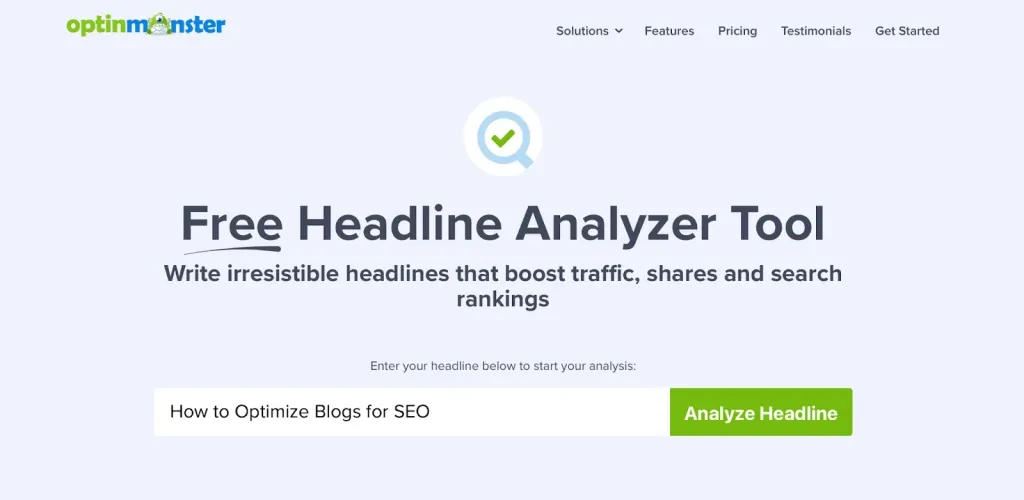When it comes to writing blogs, you often hear about search engine optimization (SEO), a fairly complex and broad topic that has changed over the years as search engine algorithms have evolved.
If you’ve ever felt overwhelmed when thinking about optimizing your blogs for SEO, you’re in the right place. Here, we’ll discuss what SEO is, some factors that impact blog SEO, and several tips you can use to start optimizing your blogs today.
Table of Contents
What is SEO?
Why is SEO important when writing blogs?
Technical factors that affect blog SEO
How to optimize blog content for SEO
Conclusion
What is SEO?
SEO, or search engine optimization, is the practice of optimizing a website or online content to improve its visibility and ranking in search engine results pages (SERPs).
The primary goal of SEO is to increase organic (non-paid) traffic to a website by making it more accessible and appealing to search engines like Google, Bing, or Yahoo. It involves various techniques and strategies, including keyword research, content optimization, on-page and off-page optimization, and other factors, all aimed at enhancing a website’s position in search results for specific keywords or phrases.
Why is SEO important when writing blogs?
When a search engine like Google indexes a blog, SEO impacts the page’s ranking, which is defined by how visible it will be to those searching for content.
Additionally, one of the reasons why blogging can be so helpful as a marketing strategy is that it improves your entire website’s SEO. A blog does this by increasing the number of indexed pages on your website, allowing you to optimize for more keywords.
Technical factors that affect blog SEO
There are a few simple factors that can significantly impact on-page SEO – the optimization within the blog post itself. These include:
- Page speed: This is the time it takes for a web page to load fully in a web browser. It’s a critical factor in SEO because faster-loading pages provide a better user experience. Google and other search engines consider page speed when ranking websites. A slow-loading blog can lead to higher bounce rates (the percentage of users who leave your site after viewing a single page) and potentially lower search engine rankings.
- Mobile responsiveness: This is how well a website or blog adapts and functions on mobile devices, such as smartphones and tablets. A mobile-responsive blog is designed to provide an optimal user experience on smaller screens. Search engines prioritize mobile-friendly websites in their rankings, as mobile traffic is a significant part of internet usage.
- Recent data: In SEO, recent data typically refers to how “fresh” content is. Search engines often value recently updated and current content, especially for topics that frequently adapt and evolve. For blogs, regularly updating and adding new content can help improve your SEO, as it signals to search engines that your site is active and provides valuable information.
How to optimize blog content for SEO
Now that you understand the importance of SEO, what tricks can you use to best optimize your blogs?
#1 – Use of keywords
Start by researching relevant keywords that people are using to search for topics related to your blog. Use tools like Google Keyword Planner, SEMrush, or Ahrefs to identify high-traffic, low-competition keywords.
Then, create high-quality, informative, and engaging content that addresses the needs and questions of your target audience based on the keyword you’ve chosen.
You don’t want to stuff the keywords into the text, but you should make a note of trying to use them when writing. To improve SEO, try to include them in the title, meta description, URL, some of the subheadings, introduction, and throughout the content.
#2 – Write a compelling title
The title is the first thing potential readers will see, and it will determine whether or not they click on your blog in the first place. So, spend some time thinking about the most compelling title.

An excellent online tool to help you learn how to write great titles is this Headline Analyzer by OptinMonster.

It can also be helpful to A/B test titles to see what works best for your audience.
#3 – Outline with SEO in mind
Writing a detailed outline with SEO in mind can make all the difference when writing new content. It can help you to organize your ideas to ensure you thoroughly answer the question, ensure you are thoughtful about your target keywords, and help you to figure out the best places to include other elements like visuals, stats, or quotes.
#4 – Ensure content is comprehensive and easy to read
While thinking about keywords is essential, what’s even more critical is ensuring that your content is both of high quality and comprehensive. Your blog content must thoroughly answer the questions your readers are searching for.
Blog content should also be easy to read and skimmable; this can be achieved by using subheadings that allow readers to understand what sections are about, writing short paragraphs, and utilizing bulleted lists.
#5 – Use images and ensure they’re optimized and use alt text

Using images is critical to break up the text and keep readers engaged, but there are ways to further optimize images.
As we mentioned, page load speed is a significant factor in SEO, and images can impact the load speed. So, ensure that images aren’t too large, or compress them so they don’t impact load speed. Note: It’s also helpful if the images are responsive to mobile so they don’t detract from the browsing experience on other devices.
It’s also vital to consider alt text.
What is image alt text?
Image alt text is a brief description of an image on a web page. It serves as an alternative representation of the image, primarily for users who cannot see the image due to disabilities or because the image doesn’t load. Image alt text is an essential accessibility feature, but it also plays a significant role in improving SEO for the following reasons:
- Search engine understanding: Search engine crawlers and algorithms cannot “see” images as humans do. Alt text provides search engines with valuable information about what the image represents.
- SEO for image search: Alt text is crucial for image search optimization. When users perform image searches, search engines use alt text to determine which images are relevant to the search query. Descriptive alt text can help your images appear in relevant image search results.
- Keyword optimization: Alt text allows you to include relevant keywords associated with the image and the content of your web page, positively impacting your page’s SEO, especially if the image is directly related to the topic of the page.
To optimize image alt text for SEO, consider the following best practices:
- Be descriptive: Provide a concise and accurate description of the image. Use relevant keywords when they fit naturally.
- Avoid keyword stuffing: Do not over-optimize alt text with excessive keywords. Alt text should read naturally and be genuinely descriptive.
- Keep it concise: Alt text should be brief and to the point. Try to stick to 125 characters or less.
You may also want to include original photos, GIFs, or graphics whenever possible to stand out.
#6 – Use links
While backlinks (links to other blogs or sections on your site) can significantly increase the likelihood of your blog ranking, they aren’t the only linking strategy.
Internal links create a logical structure for your blog. When search engines crawl your site, they use these links to discover and index your content more efficiently. This helps to ensure that all your pages are visible in search results.
Internal links can also keep readers engaged and reduce the bounce rate. A lower bounce rate can positively impact your SEO by indicating that visitors find your content valuable and relevant.
Additionally, internal links can bring attention to older posts, giving them new life and increasing their visibility.
#7 – Optimize the meta description

A meta description is a brief HTML element that provides a concise summary of a web page’s content. It’s typically displayed on search engine results pages (SERPs) beneath the page title and URL, and it helps potential readers determine if the post will answer their search query. A meta description can determine whether or not someone clicks the link.
Meta descriptions should accurately describe the content of the blog clearly and concisely and include the long-tail keyword you’re trying to rank for. But it should also be engaging to grab the readers’ attention and entice them to click.
Finally, it’s important to note that even if you do everything you can to optimize your blog, it still may not rank. If this is the case, consider how competitive the keyword that you’re trying to rank for is (for smaller blogs, you’ll want to try to rank for less competitive long-tail keywords). It’s also important to regularly check your blog metrics to see how they are performing so you can make changes to improve your chances of ranking.
Conclusion
SEO is a vital component of successful blogging in today’s digital landscape. Understanding what SEO is and its importance in enhancing your blog’s visibility is the first step.
By implementing these SEO strategies, you can make your blogs more accessible and appealing to search engines and your target audience, ultimately driving more organic traffic to your website. In short, don’t be overwhelmed by SEO – instead, embrace it as a valuable tool in your blogging journey.



